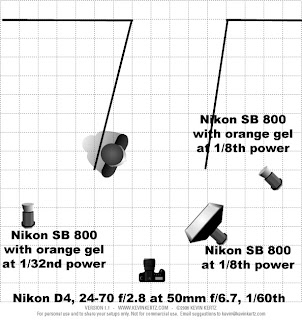Today’s photo is another one
demonstrating repeating flash.
In my last post, I showed a photo
of the how the master and remote flash was set however I did not explain the
various settings. Everything is
controlled on the master flash. On
the master, I set Group A to RPT (repeating), Channel 3, the power setting at
1/8th, number of flashes 8 and the Hz (the number of flashes per
second) at 8. I then set the
remote flash to be on Channel 3 and in Group A.
In today’s photo, I had a dancer
moving across the stage with three remote flashes hanging from a rod above the
dancer’s path. Again, the hard
part of the photo was timing and making sure that the camera did not pick-up
too much of the light build-up on the floor.
Enjoy.
 Camera settings: Nikon D4
on a tripod, 24-70mm f/2.8 at 50mm, ISO 100, f/8 at two seconds on a tripod.
Camera settings: Nikon D4
on a tripod, 24-70mm f/2.8 at 50mm, ISO 100, f/8 at two seconds on a tripod.
Post Processing:
Lightroom 4—applied Nikon
Vivid preset during import, set white and black points and added vibrance.
Photoshop CS5—cloned-out
some of the light build-up on the floor.












